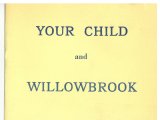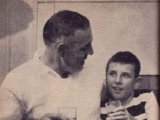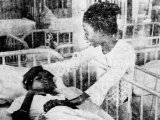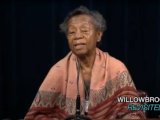You are here:
Willie Mae Goodman Fighting Willowbrook
Throughout the twentieth century, New York law said that children had to attend school. Yet for much of the century, many New York children who were of school age still did not go to school. There were many ways that children could be excluded from school, often connected to ableism, racism, and homophobia.1 Meanwhile, some students who did attend school found themselves in separate classes or programs that were not designed to help them learn.2
Read More
Many students who were excluded from school lived in institutions. Families might have opted to send their loved ones to these institutions. But other children and adults were required to be there, by the courts or by educators.
Some of these institutions first opened in the 19th century as places that claimed to educate and help Disabled people. More were opened in the 20th century, including the Willowbrook State School on Staten Island. Over time, these institutions became less and less like places of care and learning and more like containers or even prisons. They kept Disabled people and people labeled as disabled away from and out of view of non-disabled people.3
In the 1950s, Willie Mae Goodman was a Black woman, mother, wife, and cafeteria worker living in East Harlem.4 Her daughter Marguerite was born with developmental disabilities. Mrs. Goodman and her husband cared for Marguerite at home until she was four years old. At that point the Goodmans decided to send her to Willowbrook State School.
There were Black, white, Puerto Rican, Native, and Asian-American children and adults at Willowbrook. But Black and Puerto Rican children were much more likely to be institutionalized at places like Willowbrook. This pattern had many causes. Racism shaped decisions about who was disabled, what disability label they would have, and where they would go.5 Black and Puerto Rican New Yorkers had more limited job opportunities and many lived in poverty, making it harder for families to have resources to keep their children at home if they wanted to. Racism also created conditions such as dangerous work, violence, and unsafe living environments, that led to disabilities.6
Willowbrook was overcrowded and unsafe for all of its residents. Children and adults living there did not get the care they needed or deserved. Public criticism of the conditions there helped push the school to move some of its residents to a different facility.7 Marguerite was transferred to the Gouverneur Hospital in lower Manhattan. It was easier for Willie Mae Goodman and many other parents to visit their children at Gouverneur, since it was closer to their homes. But Gouverneur was, like Willowbrook, in very poor condition.
While Marguerite Goodman was at Gouverneur Hospital, her mother became a political activist as well as an advocate for her daughter. Willie Mae Goodman founded the Gouverneur Parents Association and led it for years. She worked alongside José Rivera, whose brother also lived at Gouverneur. Goodman and the Gouverneur Parents Association members used legal suits, direct protest including a traffic-stopping sit-in, and persuasion to try to improve the treatment of the children who lived at Gouverneur.8 The Gouverneur Parents Association’s activism won some changes for their children and others. Their victories were some of the first wins in parents’ struggles for rights for their disabled children living in institutions in New York City.
In 1987, after more pressure from both the media and residents, the state closed Willowbrook. Its closure was part of a national movement of deinstitutionalization of people with disabilities.9 Former residents like Marguerite were transferred to smaller facilities closer to their parents and communities. Marguerite moved to a smaller facility in East Harlem, near to her mother’s apartment.
Librarian and researcher Jorgé Matos Valldejuli studies the activism of Mrs. Willie Mae Goodman and other Black and Puerto Rican people who fought for their disabled family members and for themselves. Recognizing that most histories of civil rights movements have neglected disability, and most disability histories have focused on white people, Matos Valldejulli describes his work as a project of “redress.” He works to correct this historical misrepresentation and to recognize people like Willie Mae Goodman who faced and challenged racism in their fight for disability justice.10
-
Judith Kafka, “Growing up Together: Brooklyn’s Truant School and the Carceral and Education State, 1857-1924,” Journal of Urban History 49, no. 5 (2023): 974-94, https://doi.org/10.1177/00961442221142053; Carl Suddler, Presumed Criminal: Black Youth and the Justice System in Postwar New York (New York: New York University Press, 2019); Hugh Ryan, The Women’s House of Detention: A Queer History of a Forgotten Prison (New York: Bold Type Books, 2022); Nirmala Erevelles, “Crippin’ Jim Crow: Disability, Dis-Location, and the School-to-Prison Pipeline,” in Disability Incarcerated: Imprisonment and Disability in the United States and Canada, ed. Liat Ben-Moshe, Chris Chapman, and Allison Carey (New York: Palgrave Macmillan, 2014). ↩︎
-
Francine Almash, “New York City ‘600’ Schools and the Legacy of Segregation in Special Education,” The Gotham Center for New York City History, June 21, 2022, https://www.gothamcenter.org/blog/new-york-city-600-schools-and-the-legacy-of-segregation-in-special-education; James Haskins, Diary of a Harlem Schoolteacher, Classics in Progressive Education (New York: New Press, 2008); Keith A. Mayes, The Unteachables: Disability Rights and the Invention of Black Special Education (Minneapolis: University of Minnesota Press, 2023). ↩︎
-
James W. Trent, Jr., The Invention of the Feeble Mind: A History of Mental Retardation in the United States (Berkeley: University of California Press, 1994); David Rothman and Sheila R. Rothman, The Willowbrook Wars (New York: Harper and Row, 1984); Jorgé Matos Valldejuli, “‘Together we arrived and together we shall leave’: The Gouverneur Parents Association and the Politics of Race and Disability in Postwar New York,” Latino Studies 20, no. 4 (December 2022): 428-54; Steven Noll, “Institutions for People with Disabilities in North America,” in The Oxford Handbook of Disability History, ed. Michael Rembis, Catherine Kudlick, and Kim E. Nielsen, Oxford Handbooks (2018; online edn, Oxford Academic, July 10, 2018), accessed April 21, 2023, https://doi.org/10.1093/oxfordhb/9780190234959.013.19. Thanks to Francine Almash for the citation. ↩︎
-
Jorgé Matos Valldejuli, “The Racialized History of Disability Activism from ‘The Willowbrooks of this World,’” https://activisthistory.com/2019/11/04/the-racialized-history-of-disability-activism-from-the-willowbrooks-of-this-world1/. ↩︎
-
Matos Valldejuli, “The Racialized History of Disability Activism”; Matos Valldejuli, “‘Together we arrived’”; Mayes, The Unteachables; Almash, “New York City ‘600’ Schools”. ↩︎
-
Rabia Belt, “The Fat Prisoner’s Dilemma: Slow Violence, Intersectionality, and a Disability Rights Framework for the Future,” Georgetown Law Journal 110, no. 4 (2022): 785-833; Nirmala Erevelles, “Race,” in Keywords in Disability Studies, accessed April 19, 2023, https://keywords.nyupress.org/disability-studies/essay/race/. ↩︎
-
Matos Valldejuli, “The Racialized History of Disability Activism.” ↩︎
-
Matos Valldejuli, “‘Together we arrived.’” ↩︎
-
Matos Valldejuli, “The Racialized History of Disability Activism.” ↩︎
-
Matos Valldejuli, “The Racialized History of Disability Activism.” ↩︎





